Planning April 2020
Is Fast-Food Through With Drive-Thrus?
Responding to pressures from consumers and planners, a new generation of fast-food restaurants is replacing the familiar cookie-cutter, car-centric prototype.
By Brian Barth
Along the Southern California coastline, a surfer's paradise, it's not hard to find a walk-up taqueria to grab a quick, inexpensive, and relatively healthy Mexican meal after a day in the sun. The typical vibe is airy and relaxed, with outdoor seating and splashes of sunset pastels on the walls and furnishings. A SoCal beachside taqueria is likely independently owned, or perhaps part of a small regional chain. Most of the oceanfront was developed decades ago and is subject to strict zoning rules and design standards that maintain an eclectic, pedestrian-friendly environment. This dining experience checks many of the boxes of the shop-local ethos, the long-ascendant trend, which, in 2017, Taco Bell decided it wanted to get in on.
That year, the company opened a prototype restaurant in Newport Beach — an upscale community in Orange County — with murals by local artists, no drive-through, and enormous windows that crank open to let in the balmy air of the Pacific. There is even beer on tap, including Beach Bell — a "Mexican-style amber lager," according to the company, produced by a local microbrewery "specifically to complement the Taco Bell menu."
Dubbed a Taco Bell "Cantina," the company has been rolling this new prototype out across the country, with plans to open 300 sites by 2022, all of them without a drive-through window.
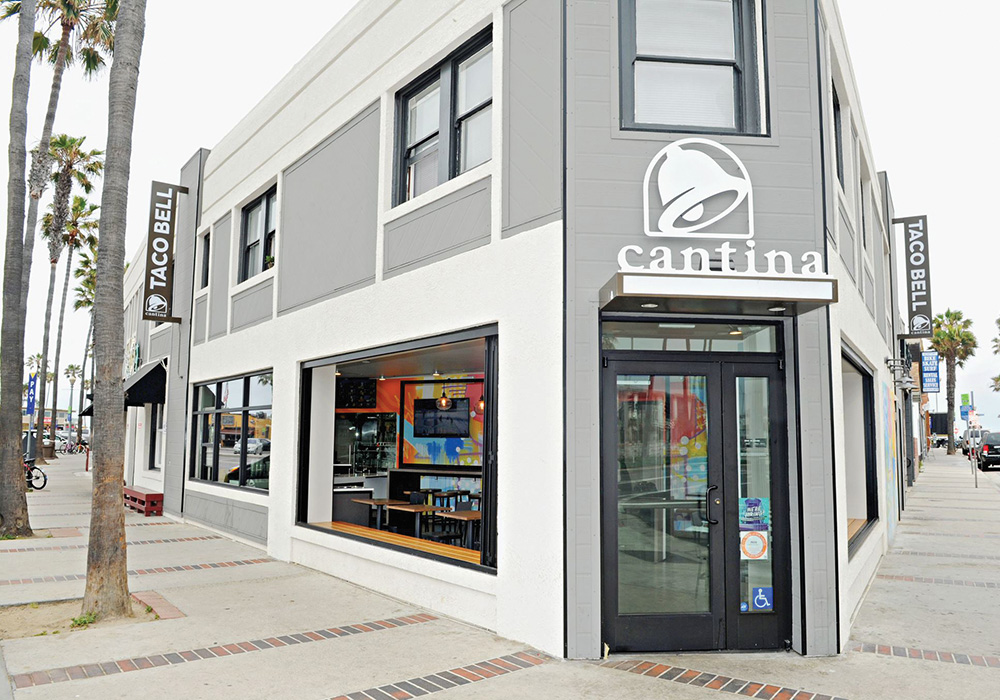
The Taco Bell Cantina in Newport Beach, California, opened in 2017 and was the prototype for the chain's new concept: restaurants with beer on tap and no drive-through windows. Photo courtesy Taco Bell.
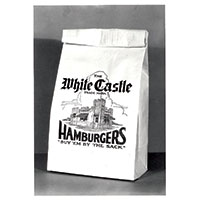
1921
It's a far cry from the stereotypical image of a fast-food restaurant — big, gaudy sign among a sea of big, gaudy signs stretching along a suburban arterial road with no sidewalks — which in many ways is the antithesis of what is today considered good urban planning. Fast food and car culture would appear to be joined at the hip. This is largely due to the industry's business model, which relies on drive-throughs to drive sales, which in turn drives a site design that requires frequent curb cuts, deep setbacks, and oceans of asphalt. It's a model totally at odds with prevailing trends in urban areas, as well as the so-called town center developments springing up in suburban and peri-urban environments, find block-style, zero-lot-line layouts that preclude traditional drive-throughs.
"For planners, the fault line with the fast-food world is the drive-through," says Terry Shook, the cofounder of the firm Shook Kelley, which specializes in urban planning services for the food and beverage industry. Anti-drive-through sentiment "is like the litmus test of whether or not you're a true believer or an apostate" in planning, he jokes, while acknowledging that the industry, and likely the drive-through, will continue to play an outsize role in urban development for the foreseeable future.
Shook sees the fast-food debate as emblematic of a clash between two uniquely American ideals: "It's a fight between personal fulfillment — I want my burger cheap and I want it now," he says, and "the common good — I want to eat it in a beautiful, walkable environment. That's the planner's dilemma."
Will the drive-through go the way of the dinosaur? Many municipal leaders, having recently implemented bans on new drive-through construction, seem to hope so. But there is a complex set of competing priorities at play that make this issue more gray than black and white.

1948
Evolution of fast food
The complicated love affair between America, fast food, and car culture stretches back nearly 100 years to 1921, with the opening of the first White Castle restaurant in Wichita, Kansas. The first White Castle drive-through did not come along until six decades later, but the chain was a product of car culture nonetheless. The company's thriving burger business mirrored the booming sales of the Model T Ford; Americans, newly liberated by the world's first affordable automobile, flocked to White Castle, which was built around the then-novel idea of food to go. Moreover, the restaurant itself took a cue from Henry Ford's assembly lines: The meals were produced quickly and uniformly, with an identical experience provided at every location.
The cookie-cutter approach to food has fallen out of fashion. But at the time it was hailed as ingenious, a sign of progress that ensured the reliability not only of service and flavor, but of safety; the public health standards we take for granted today were in their infancy at the time. White Castle's sterile white surfaces and stainless-steel equipment were seen as the future of dining.

1968
White Castle's take-out model spawned various car-centric permutations, including the drive-in, in which an intercom device stood next to each parking space; shortly after your order was placed, a car hop would run, or skate, out with your food. In 1948, Dick and Mac McDonald remodeled their drive-in barbecue restaurant in San Bernardino, California, in an effort to economize. They got rid of carhops, cutlery, and most of the menu, refashioning the restaurant with a burger, cheeseburger, and seven other menu items, served from a walk-up window and designed to be eaten with the hands out of disposable packaging. The name of the game was speed (they dubbed their factory-like process the Speedee Service System), which allowed them to sell their burgers cheaper and undercut the competition.
That same year, In-N-Out Burger introduced another variation on the theme at its Baldwin Park, California, location, which had no dining room or parking, only a driveway with an intercom system for taking orders. But this set-up did not immediately catch fire with the other fast-food chains that were emerging. McDonald's did not open its first drive-through until 1975, in Sierra Vista, Arizona. Sales increased dramatically, and within five years, more than half of McDonald's locations had drive-throughs, a trend that swept through the rest of the industry. Today, about 70 percent of all fast-food sales in America takes place at drive-through windows.

1969
"Urbanization, white flight, the interstate highway system, commuting to work: fast food is a product of all these forces," says Adam Chandler, a journalist whose 2019 book Drive-Thru Dreams: A Journey Through the Heart of America's Fast-Food Kingdom trains a sociohistorical lens on the subject. "By the late '80s, wage stagnation and the rise of two-income households meant people wanted to devote less and less time to cooking and eating, which cemented the drive-through as a very specifically American aspect of car culture."
Dunkin' Donuts has the fastest fast-food drive-through, with an average wait time of three minutes, 37 seconds. An artificial intelligence company is currently testing a system to replace human drive-through workers with an Alexa-like virtual worker for taking orders, which claims to shave 25 percent off the average drive-through wait time. Fast food's ongoing obsession with speed and cost, often at the expense of other priorities, has made it a $570 billion global industry — but it is also its greatest vulnerability.
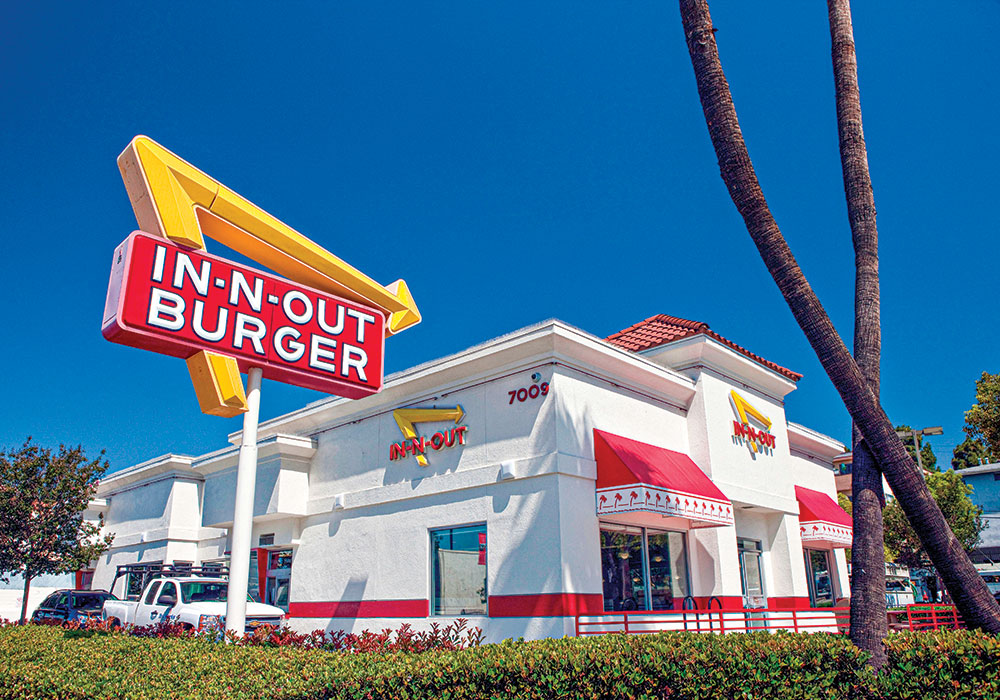
Under a bright Los Angeles sky, a big In-N-Out Burger sign and a long drive-through lane symbolize the heyday of fast food's car-culture origins. Although some communities are fighting this typology through bans and zoning restrictions, some advocates say the drive-through model still serves a need. Photo by E. J. Baumester Jr./Alamy.
Design challenges
As a reliable generator of sales tax revenue, and as a provider of jobs for those who might otherwise struggle to find employment, fast food has long had an upper hand in arguing for the lax land-use regulations that enable the strip-style development pattern that favors drive-through businesses. As urban design ideals and best practices have shifted to embrace walkability and "Main Street" aesthetics, some communities have fought back with antisprawl initiatives, often limiting drive-throughs, and the large signage associated with them, to specific areas. But more and more are targeting drive-through restaurants with blanket, citywide bans pushed through on the basis of both urban planning and public health principles.
1982
San Luis Obispo, a small city in the coastal California hills, instituted a ban back in 1982 (thought to be the first in the country), citing traffic concerns and community character, a move soon followed by other scenic communities on the West Coast and elsewhere.
When the "obesity epidemic" became a national conversation in the 2000s, another wave of bans unfurled, most notably in Los Angeles, which in 2008 instituted a ban in several low-income neighborhoods on the city's south side, where obesity rates were particularly high. Even Baldwin Park, the California town where In-N-Out opened the world's first drive-through, implemented a temporary ban in 2010.
More than two dozen Canadian cities have full or partial bans, including the metropolises of Vancouver, Calgary, and Toronto. Bans have been proposed in large American cities, including New York, but the first to pass in a district with over 400,000 residents was last year in Minneapolis. Obesity was not the concern cited by city council, which was more focused on reducing vehicle emissions, litter, and the dangers to cyclists and pedestrians at all those curb cuts.
"If somebody said, let's ban drive-throughs nationwide, that would cripple the QSR [quick-service retail] industry," a fast-food franchise owner warned on qsrweb.com, a site catering to the industry, back in 2008. "I think we better have a Plan B in place, because this is creeping up on us."
There has been significant pushback to the bans, and not just from the fast-food industry. In Minneapolis, disability advocates formed the most vocal opposition, arguing that it was an ableist abuse of zoning powers — people who have difficulty getting in and out of a car and walking short distances (especially in a place with brutal winters, like Minneapolis) rely on drive-throughs, they said (drive-through pharmacies and banks are also subject to the ban).
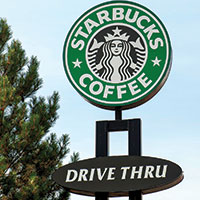
1994
Planner Bobby Boone, AICP, who founded &Access Retail, sees discrimination of a wider sort at work: urbanites who disdain the very idea of fast food, without acknowledging the role it plays in food access for low-income residents.
"Fast-food restaurants are quick, convenient, and cheap, which is why they meet the needs of a wide spectrum of the population throughout the nation," says Boone, who, as the child of a single parent with an hour-plus commute, has personal experience with the issue. "My opinion is they're not accepted in many affluent communities because those brands are associated with lower income communities."
Moreover, Boone says that the suburban typology associated with drive-throughs that is so often scorned is often a critical factor in the ability of those restaurants to meet the demand of customers who most need access to quick, inexpensive food. As an example, he notes that the large signs historically favored by fast-food franchises on arterial roads are largely a function of the speed limit: they need to be that big for motorists to register in the brief window they have before it's too late to turn in. If planners want to reduce the allowable sign dimensions, he suggests that they argue for reducing the speed limit accordingly. Otherwise, fast-food franchises are less likely to locate there, and low-income residents may find themselves perusing the dining options at gas stations and convenience stores instead.
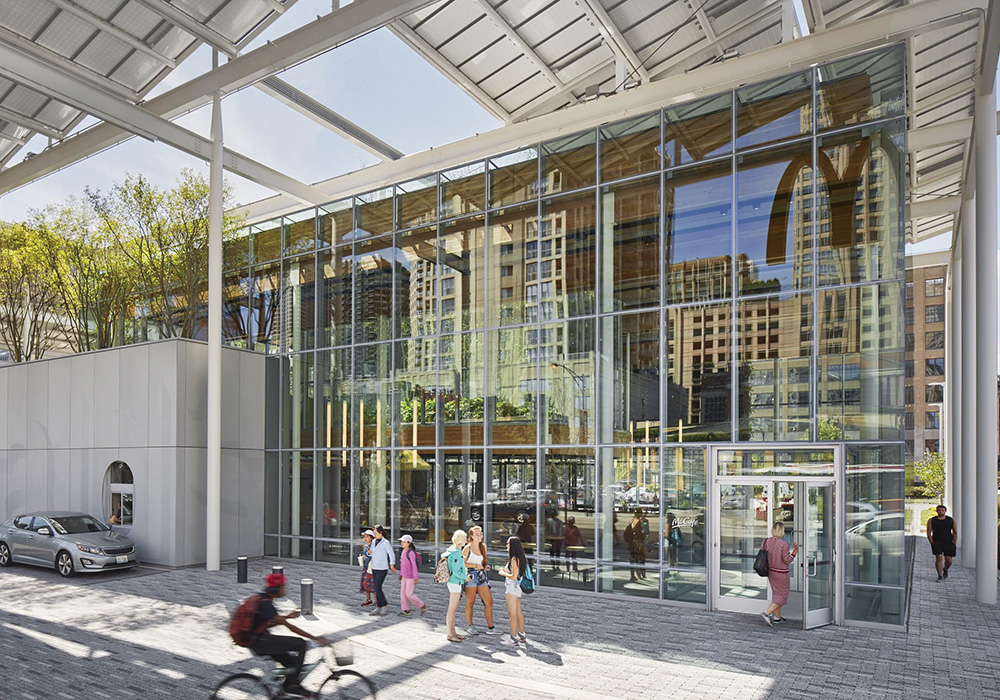
In a sign of just how far the fast-food industry has come in its hundred years of existence — and just how far it is willing to go to change its image — McDonald's recently opened what is surely the world's fanciest drive-through in Chicago. The sleek steel-and-timber structure is topped with a canopy of solar panels that extend beyond the building to shade the permeable-paver parking lot, which is further shaded by 70 trees on the grounds. The interior is bathed in natural light and includes a garden of ferns and white birch trees, plus an array of vegetation along "living" walls. This is definitely not your grandparents' McDonald's. Kendall McCaugherty, Hall+Merrick Photographers, courtesy Ross Barney Architects.
Boone adds that proponents of bans may imagine that healthier "fast-casual" restaurants — almost as cheap and fast as fast food, but with a dine-in format (such as Chipotle, Panera, Sweetgreen, CAVA, and Urban Plate) — will fill the voids where drive-throughs are banned, but he thinks that's wishful thinking. "Panera may plan to open five new locations in a given region, but they're going to pick places that match their predefined model of household income, access to a vehicle, educational attainment, etc. That often leaves out the communities which McDonald's is willing to go into. It ends up creating a disparity between affluent communities and low-income communities, or communities of color, where some brands don't see as much value."
As for the obesity epidemic, there's no question that the fast-food industry plays a significant role. But it's unclear whether zoning regulations limiting drive-throughs are an appropriate means to address it. In the Los Angeles neighborhoods where drive-throughs were banned in 2008, a study four years later found that obesity rates actually went up.
Food for thought
Some planners suggest a more nuanced approach that seeks a balance between the negative externalities of fast-food restaurants and the benefits of the food access they provide. This requires a granular approach both to assessing neighborhood needs and understanding the intricacies of the industry.
Michael Berne, a planning consultant with offices in New York and Berkeley, California, points out that fast-food franchises are happy to forgo drive-throughs in certain circumstances — namely where pedestrian traffic is high enough that they can achieve a similar level of sales per hour — a calculus that also has to be squared with real estate costs, which tend to be much lower along suburban arterials than in dense, walkable neighborhoods. Likewise, they will modify their signage, exterior materials, square footage, and setback and parking preferences if they see a market opportunity that makes it worthwhile to do so. This is why you occasionally see fast-food franchises in all sorts of car-unfriendly environments, from campuses and transit centers to pedestrian malls and historic districts.
2008
"How far they are willing to get away from their prototype is a function of how much they want to be in that location," says Berne. "What a lot of municipalities don't get right, or don't necessarily bother to understand, is where are they on that hierarchy? And given where they are, how much leverage do they have? If you want Taco Bell, but maybe you want an exterior that's a little more subdued, you have to think carefully about what you're going to ask, so you don't push them so hard that they walk away."
These pressures, of course — along with changing consumer preferences — are why many fast-food companies are attempting to get in on the fast-casual scene, which is largely without drive-throughs and is town center-friendly. Taco Bell Cantinas, essentially a fast-casual version of the chain, and McDonald's outposts with solar panels are a response to market demand for healthy, sustainably produced food; likewise, as long as the market demand for the cheapest, fastest meal possible remains, the fast-food industry will cater to it. The fast-casual industry is also seeking to get in on the fast-food scene, with some of the biggest players recently opening drive-through locations (Chipotle calls them Chipotlanes) — perhaps one of the clearest signs that fast food isn't going anywhere.
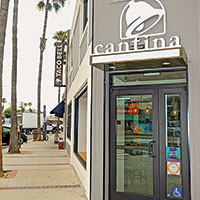
2017
The future of fast-food typologies is by no means set in stone, as technological innovations may produce unexpected outcomes. Many fast-food franchises now designate parking areas for customers who have ordered online, where workers dash out to cars with their orders, carhop-style. Delivery services are raising the bar of customer convenience, while likely adding to the carbon emissions of each meal; rather than you swinging by the restaurant on your way home from work, the Uber Eats driver is making a dedicated trip from the restaurant to your home.
The advent of "dark" or "ghost" kitchens — restaurants catering exclusively to online delivery platforms, which eliminate the need for a retail storefront — may prove to be the biggest paradigm shift to hit the industry as it enters its second century. "The future of fast food may look more like a distribution warehouse in a light manufacturing district," Boone predicts.
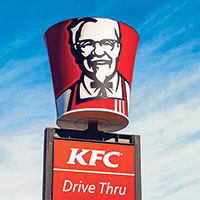
2019
Adam Chandler, whose research for Drive-Thru Dreams involved a William Whyte-like approach to observing the culture of fast-food restaurants, argues that whatever the future holds, it should not be lost on planners what the present actually looks like: fast-food establishments serve as critical "third places," the elusive zones where community cohesion spontaneously arises. People frequent fast-food restaurants not just to eat and go, but to hang out, especially marginalized groups. Seniors spend hours hanging out in the morning; teenagers who lack access to wifi for their homework make use of the abundant electrical outlets in the afternoons; homeless people, whether restaurant owners like it or not, look for access to bathrooms, a cheap bite to eat, and a warm, dry place to be.
"You find a wide cross section of humanity at fast-food restaurants because they are spaces with a low barrier to access," says Chandler. "It's air conditioned and generally pretty safe, and with some exceptions you're allowed to stay there as long as you want." Folks who support bans, he adds, are likely the rare demographic that does not go to a fast-food restaurant from time to time — "I think that's safe to say."
Chandler urges communities to hitch their ideals to the industry, just as they did back when those ideals were about the economy of mass production and the personal freedoms afforded by the automobile. Most Americans will have their first plant-based burger at a fast-food restaurant, for example. The industry is also driving incremental improvements to animal welfare on factory farms. Perhaps planners can harness the mainstreaming effect of fast food, as well. "Fast-food restaurants embody a lot of troubling aspects of American culture," says Chandler. "But in a weird way they provide a remedy for a few of them, too."
Brian Barth is a journalist with a background in urban planning. His writing has appeared in the New Yorker, National Geographic, Landscape Architecture Magazine and others.


